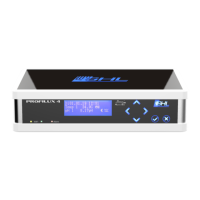ProfiLux 4 Programming Guide
EN 2017-02-06 71
This switching output is on when the temperature control wants to
heat or cool (in both cases).
With this, you can make a here connected PTC which is already
operated via a 1-10 V-interface, completely powerless if it shall
neither be heated nor cooled.
In principle you can supply a PTC permanently with power and
therefore it doesn’t need to be connected to a switchable socket,
but you can save the standby-energy through the shut-off.
In case of an alarm of this controller, the socket is switched on.
All other controllers can be selected under these options:
The control uses this switching output for the downwards-
regulation e.g. to decrease the pH-value.
The control uses this switching output for the upwards-regulation
to e.g. increase the pH-value.
In case of an alarm of this controller, the socket is switched on.
After selecting a function, the following settings can be made additionally:
Blackout delay– for the time set here (0 to 60 minutes) the switching output remains
switched off in any case after the switch-on of the ProfiLux 4. This setting is useful if
this switching output switches a device which must first cool down before it is
switched on again, e.g. if the re-switching of a MH-lamp shall be delayed after a power
failure.
Invert switching behavior – if this option is activated, then the switching output
behaves exactly inversely: if it shall be switched on, it is switched off and the other
way round. The inversion of the switching behavior is e.g. then useful if pumps or
magnetic valves shall be switched off instead of on through the level regulation.
8.4 1-10 V Interface
Each 1-10 V interface can be configured separately. ProfiLux 4 has six permanently installed
1-10 V interfaces L1 to L6 (two combined in one connection). With the PLM-2L4S or PLM-4L
expansion cards, the number of 1-10 V interfaces can be increased.
Once the interface has been selected, you can assign the desired and previously set function
to it.
Then select the Number of the illumination.
Here the dimmable lamps are then connected – e.g. with
dimmable ballasts or ProfiLux Moon. So it is possible to assign each

